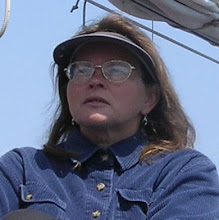We were fortunate to receive funding from the province of New Brunswick through S.E.E.D. for eight weeks and the federal Summer Placement Program, also for eight weeks. Courtney Guptill managed the Welcome Centre and Gift Shop with Jesse Gagné filling in on her days off. Courtney and Jesse greeted visitors, maintained a daily log of visitors and handled the sales in the gift shop.
 |
| Courtney accepting an order of Eric Allaby's posters. |
Jesse also helped with various tasks on the property including mowing, weeding, and painting. He also helped our volunteers to install the interpretative signs and helped our Artist in Residence, Shoshannah White move in for a three month stay.
We are very thankful to have these summer students who greeted 6159 (3124 people in July and 3035 in August). This compares with 5886 in 2011 (315 for eight days in June, 2577 for July and 2994 for August).
We did manage to have the Welcome Centre open on occasion in September (541 visitors) and the beginning of October (199 visitors) through the gracious volunteering of Frances Hodge, Linda L’Aventure, Mary McLintock, Carol Green, Alexis Phillips, and Ken Ingersoll. This compares with 398 and 110 visitors under similar circumstances in 2011 for September and early October.
 |
| Linda L'Aventure helping set up the gift shop. |
We are slowly trying to increase our inventory and had some great new items this summer, including a custom designed pewter pin. We still have t-shirts and the very popular heavy canvas tote bags. Proceeds from the sales go back into the restoration of the property.









































